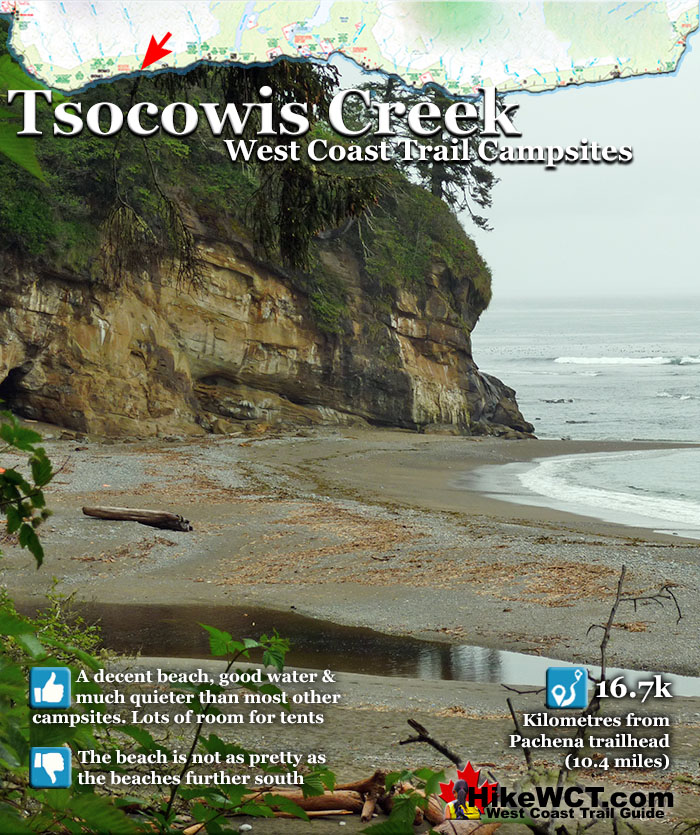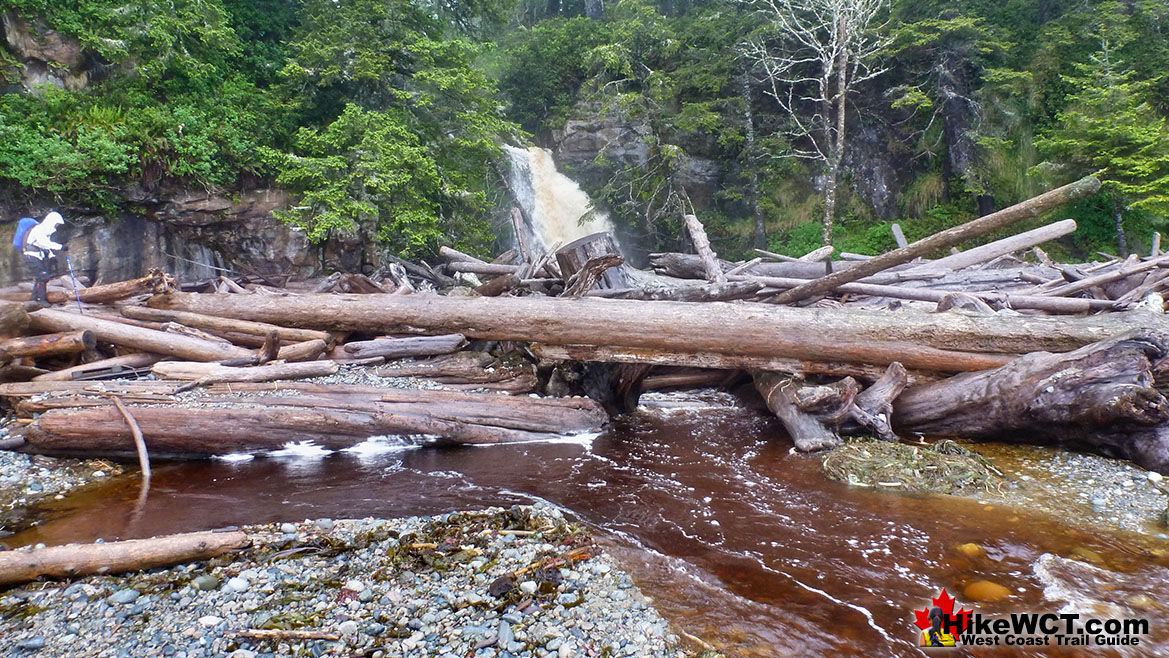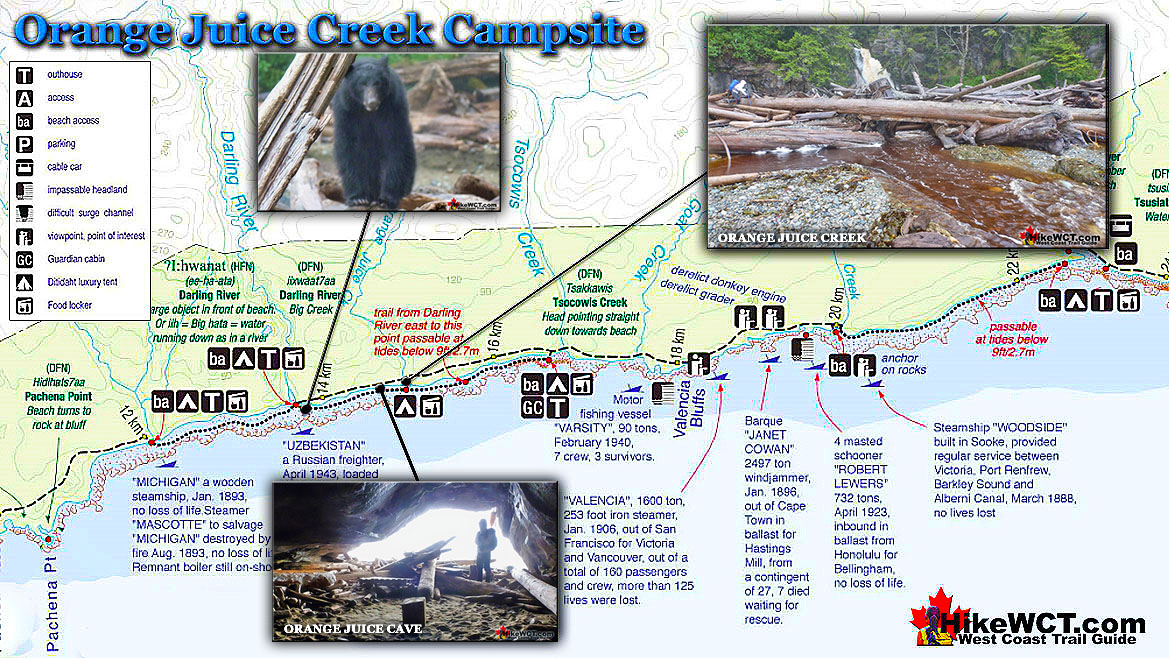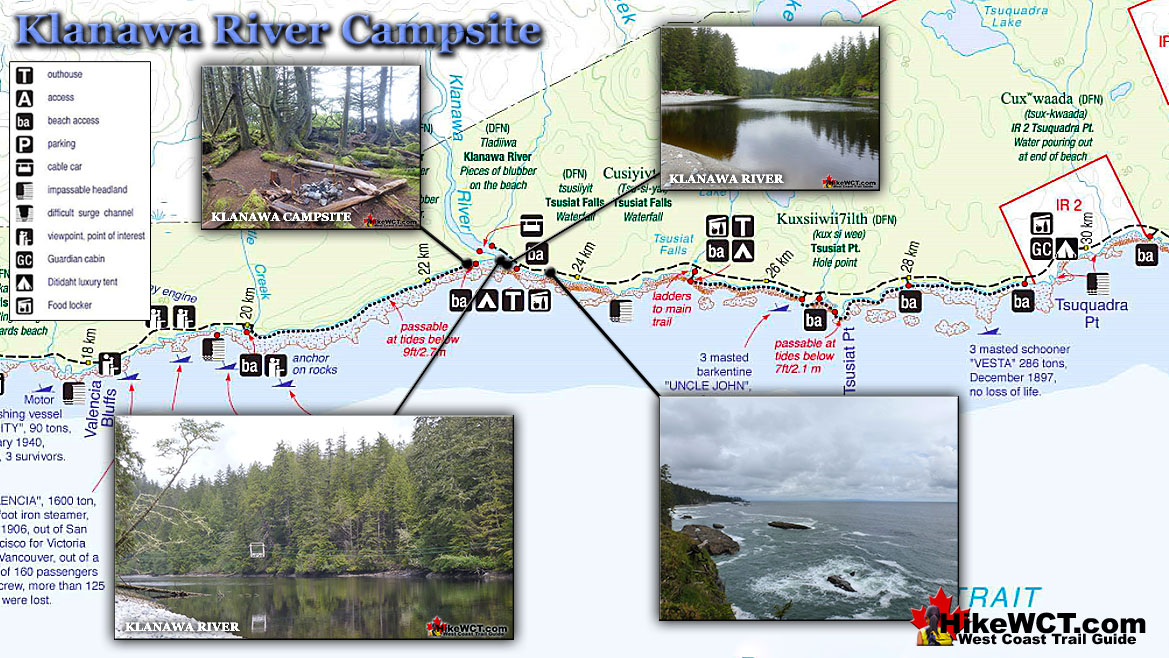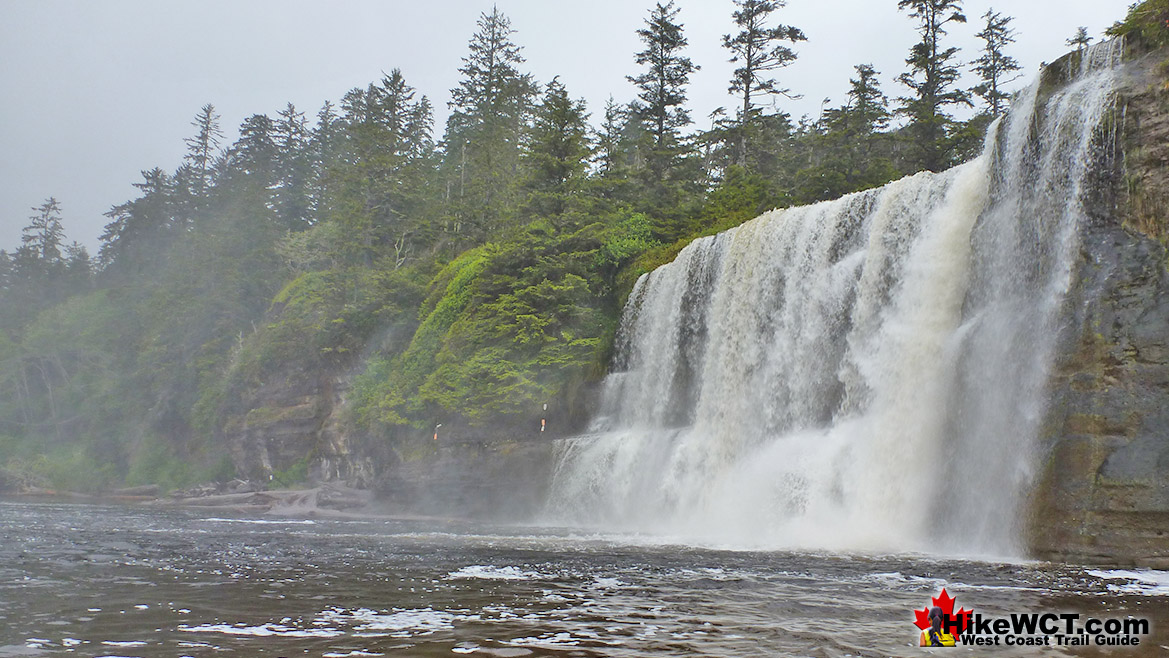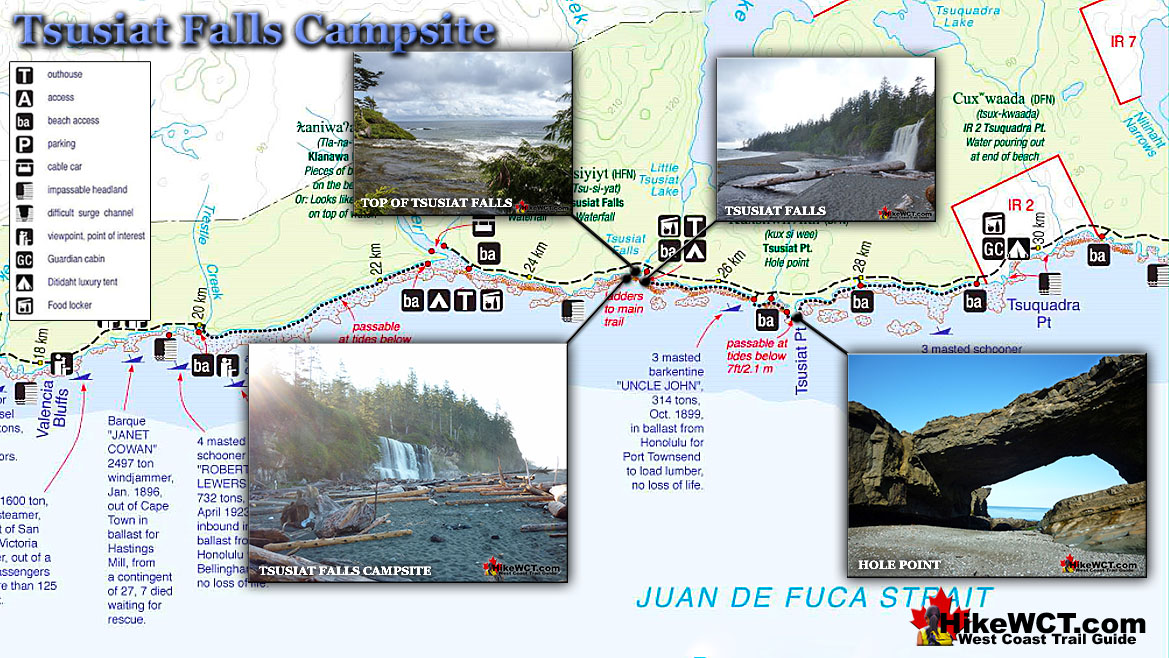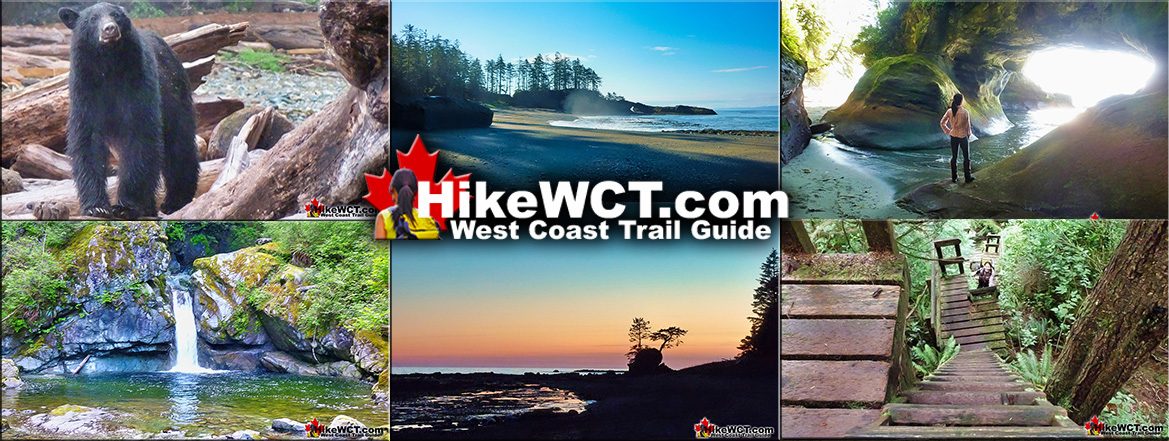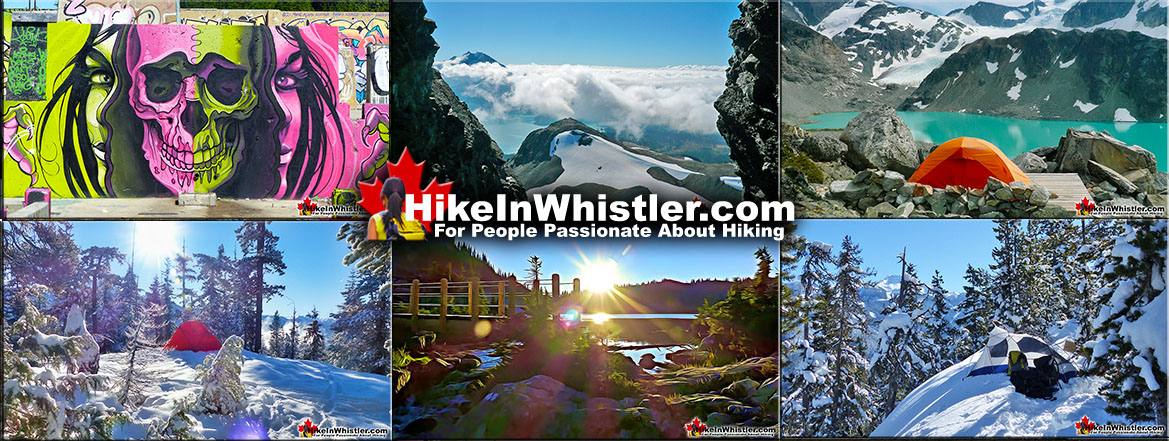![]() The Tsocowis Creek campsite at 16.5k has a decent beach with an excellent water source. Most hikers pass through the beach here on their way to Michigan if heading north or Tsusiat Falls if hiking south. The beach at Tsocowis is fairly decent and there is plenty of room for tents along the beach amongst the driftwood logs. Tsocowis Beach has a lot of interesting features to explore.
The Tsocowis Creek campsite at 16.5k has a decent beach with an excellent water source. Most hikers pass through the beach here on their way to Michigan if heading north or Tsusiat Falls if hiking south. The beach at Tsocowis is fairly decent and there is plenty of room for tents along the beach amongst the driftwood logs. Tsocowis Beach has a lot of interesting features to explore.
 Much quieter than nearby campsites
Much quieter than nearby campsites Plenty of places to explore in the area
Plenty of places to explore in the area Good water source
Good water source Nicer, sandy beach than nearby beaches
Nicer, sandy beach than nearby beaches Tons of firewood for your campfire
Tons of firewood for your campfire Sheltered by a stunning sandstone cliff
Sheltered by a stunning sandstone cliff Tsocowis Creek is not terribly pretty
Tsocowis Creek is not terribly pretty The beach is not stunning
The beach is not stunning Long hike to the Pachena trailhead
Long hike to the Pachena trailhead Beach campsites a bit messy with debris
Beach campsites a bit messy with debris
West Coast Trail Campsites
![]() Michigan Creek at 12km
Michigan Creek at 12km ![]() Darling River at 14km
Darling River at 14km ![]() Orange Juice Creek at 15km
Orange Juice Creek at 15km ![]() Tsocowis Creek at 16.5km
Tsocowis Creek at 16.5km ![]() Klanawa River at 23km
Klanawa River at 23km ![]() Tsusiat Falls at 25km
Tsusiat Falls at 25km ![]() Cribs Creek at 42km
Cribs Creek at 42km ![]() Carmanah Creek at 46km
Carmanah Creek at 46km ![]() Bonilla Creek at 48km
Bonilla Creek at 48km ![]() Walbran Creek at 53km
Walbran Creek at 53km ![]() Cullite Cove at 58km
Cullite Cove at 58km ![]() Camper Bay at 62km
Camper Bay at 62km ![]() Thrasher Cove at 70km
Thrasher Cove at 70km
Shipwreck debris, stunning sandstone cliffs with a wonderful sea cave. Tsocowis Falls brings excellent, fresh water just steps from your tent. Ladders near the campsite take you up above and over Tsocowis Falls. The view from the top of the ladders and on the bridge are fantastic. A tremendous way to view the beach below you. It is a good idea to take a long look at the beach as camping here is unexpectedly nice and far less busy than almost every other West Coast Trail campsite. The sandy beach invites you to plunge into the ocean. Parts of the beach are a bit messy with tangles of driftwood and seaweed, however for the most part, the beach is quite nice. You have the same amenities here as other West Coast Trail campsites such as deluxe outhouses and animal proof food storage boxes. Tsocowis is home to one of the West Coast Trail guard cabin's. In 1940 the survivors of the Varsity shipwreck survived by crawling their way to the shelf below what is now called Valencia Bluffs. They now found themselves on a steep shelf that they could not climb. Out of the wreckage they managed to survive exposure and construct a ladder up the cliff and found the trail that hikers now call the West Coast Trail.
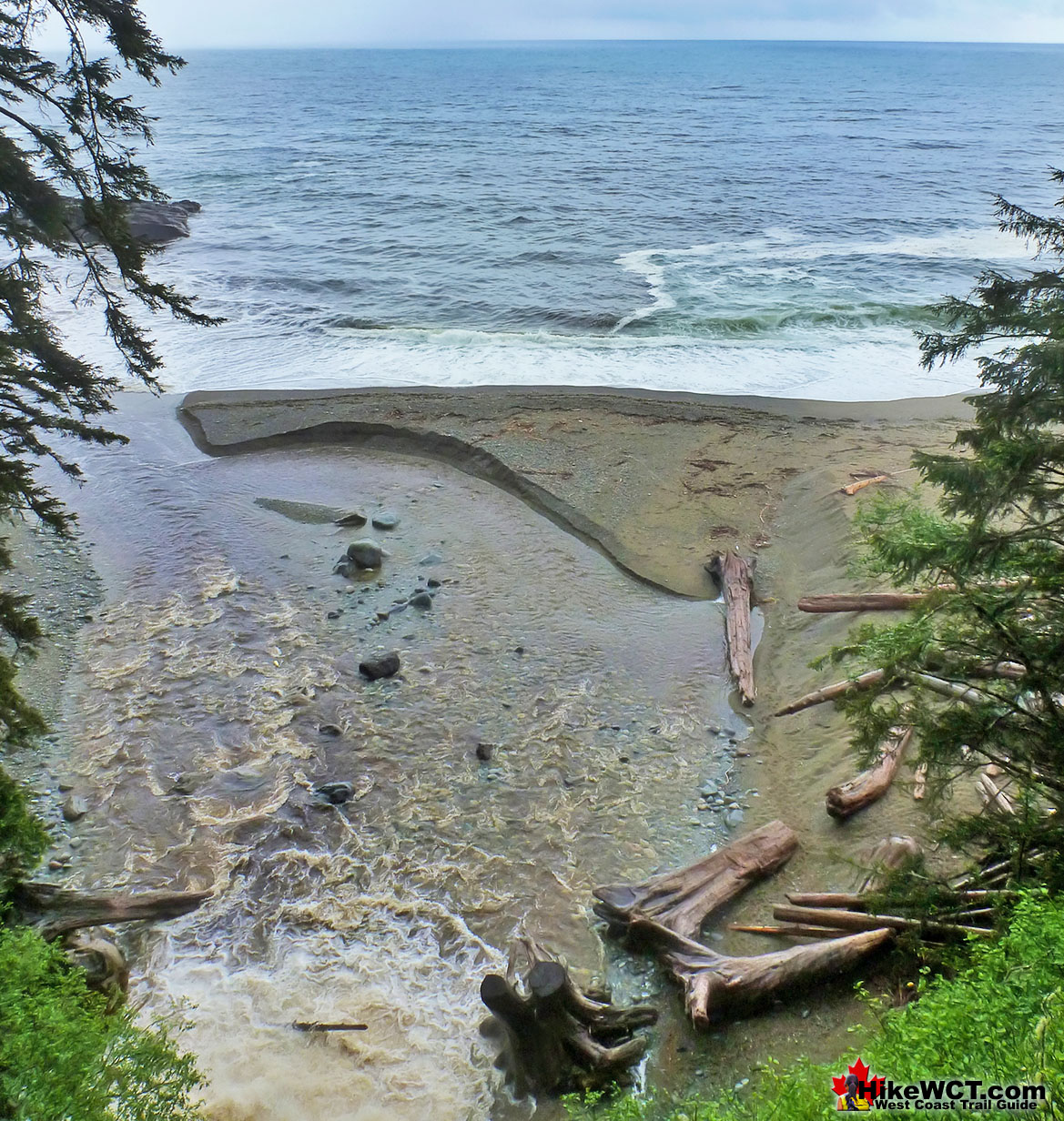
The three survivors made their way to Tsocowis Creek and found the Tsocowis cabin occupied by lineman who fortunately was there. The three were later picked up from Tsocowis Beach. Today the shipwreck's huge metal winch rusts in a crevice at the foot of Valencia Bluffs. Hikers tend to pass this campsite and push on to the end of the trail(or the next campsite if heading south). Everybody it seems camp at Tsusiat Falls or Klanawa River.
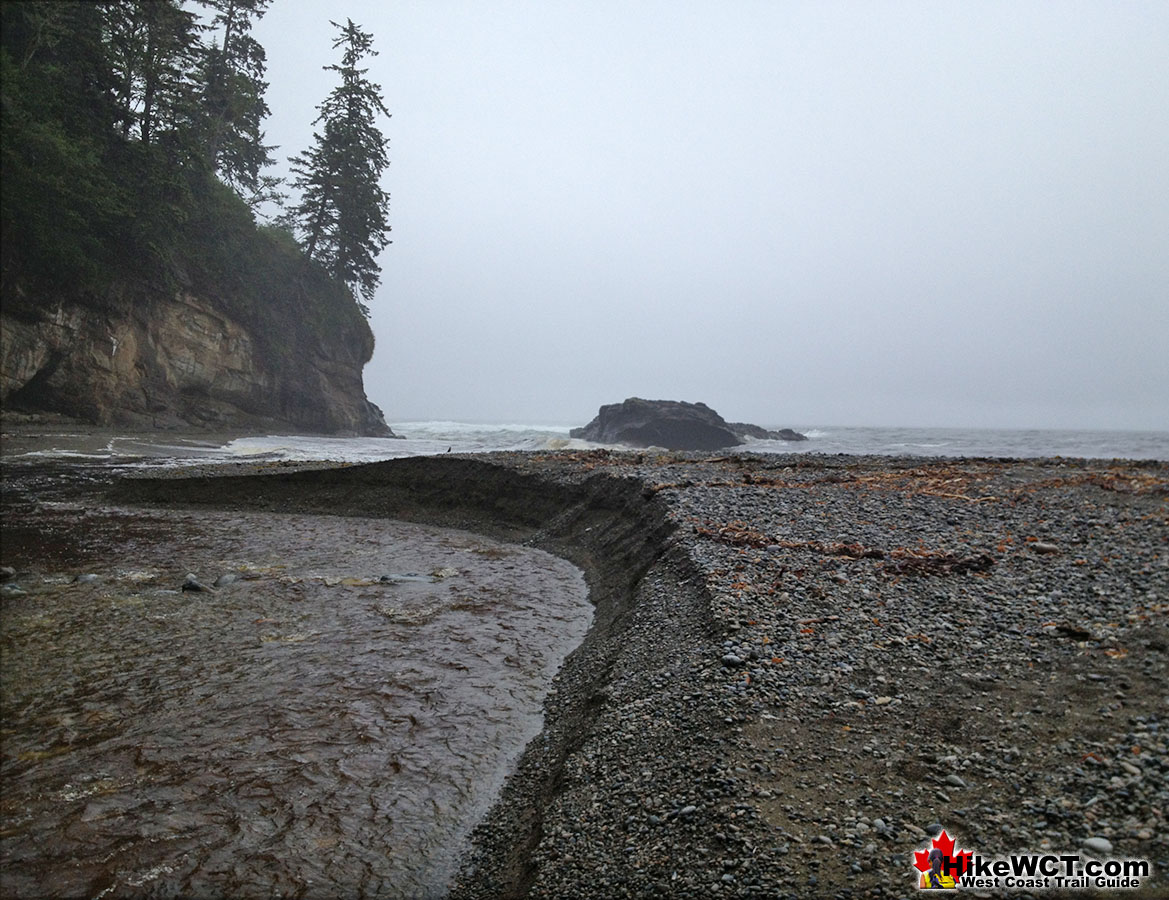
Both less than 9 kilometres further south. Tsocowis Creek is an entry or exit point from the beach trail and there is an alternate trail that runs through the forest north to Darling River. The beach route seems far better all around however, and much easier too as you don't get slowed by hiking on sand. Still, walking along the Pacific Ocean's Graveyard of the Pacific is always something special.
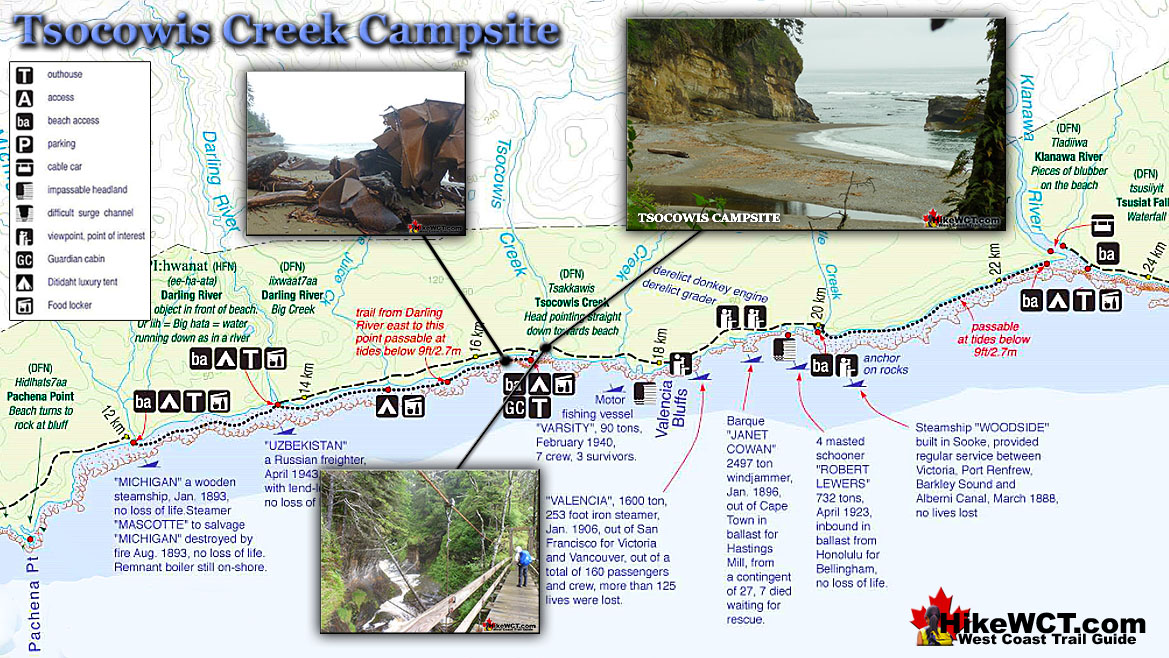
More West Coast Trail Campsites
Orange Juice Creek Campsite at 15km
![]() Orange Juice Creek is not terribly pretty and gets its name from the intensely, orange juice coloured water that crashes through a tangled morass of driftwood logs. If you aren't keen on swimming and/or washing at Darling Falls, Orange Juice Creek is a good alternative. Much quieter than Michigan Creek and a bit quieter than Darling River, you will find a more relaxed surrounding at the campsite at Orange Juice Creek. Another less obvious aspect of Orange Juice Creek that makes it worth camping at is the small, but very livable sea cave. Some find it charming, others find it spooky. At the very least it is worth a look. A small fire in the middle, surrounded by driftwood logs for seats, in horribly, wet weather, this cave is paradise!
Orange Juice Creek is not terribly pretty and gets its name from the intensely, orange juice coloured water that crashes through a tangled morass of driftwood logs. If you aren't keen on swimming and/or washing at Darling Falls, Orange Juice Creek is a good alternative. Much quieter than Michigan Creek and a bit quieter than Darling River, you will find a more relaxed surrounding at the campsite at Orange Juice Creek. Another less obvious aspect of Orange Juice Creek that makes it worth camping at is the small, but very livable sea cave. Some find it charming, others find it spooky. At the very least it is worth a look. A small fire in the middle, surrounded by driftwood logs for seats, in horribly, wet weather, this cave is paradise!
Orange Juice Creek campsite continued here...
Klanawa River Campsite at 23km
![]() The campsite at Klanawa River is quite good owing to its lovely, swimmable river and expansive beach. Though the beach is a thick, tangle of driftwood, you can still manage to find cleared areas perfect for a tent. Klanawa River is just a couple kilometres from Tsusiat Falls. Tsusiat Falls is pretty impressive and hardly any West Coast Trail hikers don't camp there. This leaves few people at Klanawa River. Beautiful beach and a wonderfully huge river, the Klanawa River campground is fantastic. And because it is close to the super popular Tsusiat Falls campground it is often quiet and serene. Also, the main trail runs to the cable car crossing which diverts the crowds away.
The campsite at Klanawa River is quite good owing to its lovely, swimmable river and expansive beach. Though the beach is a thick, tangle of driftwood, you can still manage to find cleared areas perfect for a tent. Klanawa River is just a couple kilometres from Tsusiat Falls. Tsusiat Falls is pretty impressive and hardly any West Coast Trail hikers don't camp there. This leaves few people at Klanawa River. Beautiful beach and a wonderfully huge river, the Klanawa River campground is fantastic. And because it is close to the super popular Tsusiat Falls campground it is often quiet and serene. Also, the main trail runs to the cable car crossing which diverts the crowds away.
Klanawa River campsite continued here...
Tsusiat Falls Campsite at 25km
![]() One of the most popular and beautiful campsites along the West Coast Trail. Tsusiat Falls is one of the main highlights on the trail with its dramatically wide and beautifully picturesque appearance. You will find Tsusiat Falls at the base of an extraordinary array of ladders extending hundreds of metres up into the trees. Tsusiat Falls pours over an abrupt and wide cliff onto the sandy beach. The force of the water has dug out quite a large pool that flows in an ever changing channel through the sand to the ocean. It is quite common to see whales passing in the distance from the beach at Tsusiat. The beach is raised up a few metres from the ocean and affords you a better vantage point over the ocean than you get elsewhere. Tsusiat Falls campsite is wide and extends as far as you want to go down the beach.
One of the most popular and beautiful campsites along the West Coast Trail. Tsusiat Falls is one of the main highlights on the trail with its dramatically wide and beautifully picturesque appearance. You will find Tsusiat Falls at the base of an extraordinary array of ladders extending hundreds of metres up into the trees. Tsusiat Falls pours over an abrupt and wide cliff onto the sandy beach. The force of the water has dug out quite a large pool that flows in an ever changing channel through the sand to the ocean. It is quite common to see whales passing in the distance from the beach at Tsusiat. The beach is raised up a few metres from the ocean and affords you a better vantage point over the ocean than you get elsewhere. Tsusiat Falls campsite is wide and extends as far as you want to go down the beach.
As everyone has seen pictures of it, everyone aims for it to spend the night. If you don't mind crowds then you'll love it. If you don't like crowds, you may have trouble finding a serene corner to camp. If you really want to find serenity, you might try camping at the far end of the beach where you will find quite a large sea cave. If you love waking up to whales in the distance and the beautiful roar of waterfalls nearby, then you will find that at Tsusiat. The campsite is well designed for crowds though as the hundreds of driftwood logs on the beach have fashioned partitioned areas randomly, where some sort of organized privacy exists.
Tsusiat Falls campsite continued here...
Best West Coast Trail Sights & Highlights
West Coast Trail Campsites
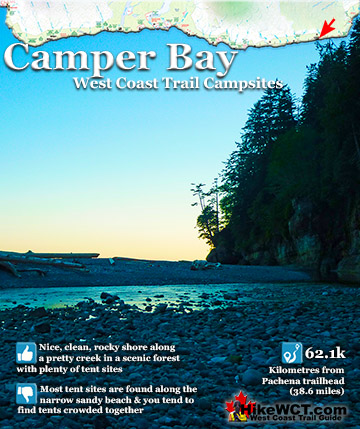
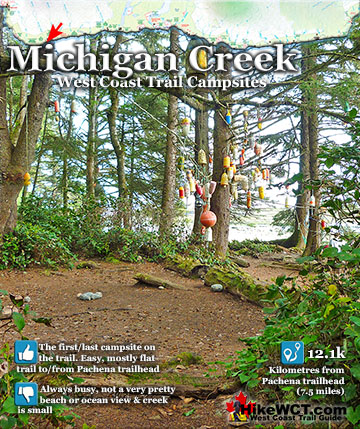
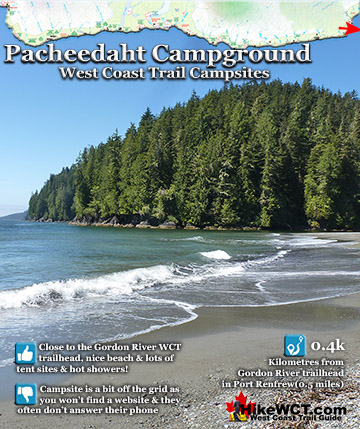
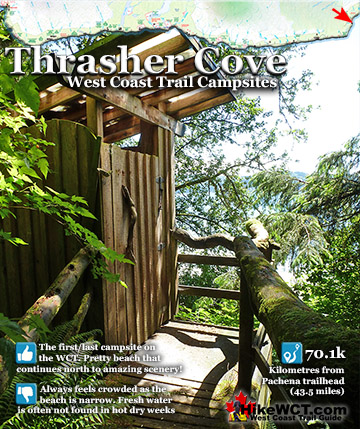
West Coast Trail A to Z
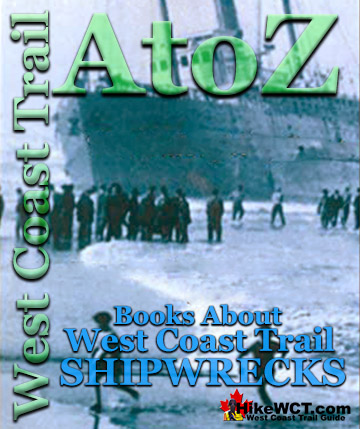
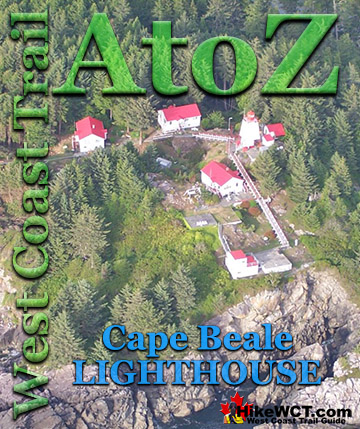
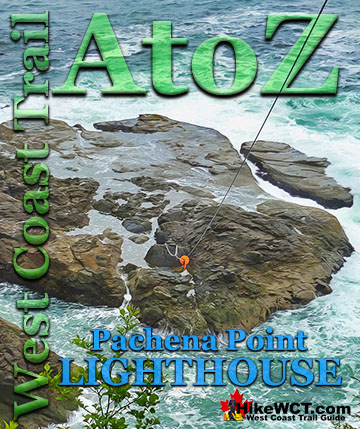
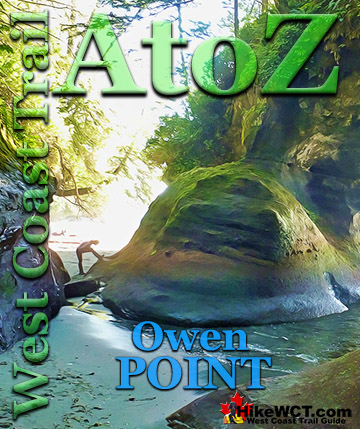
The West Coast Trail by Day
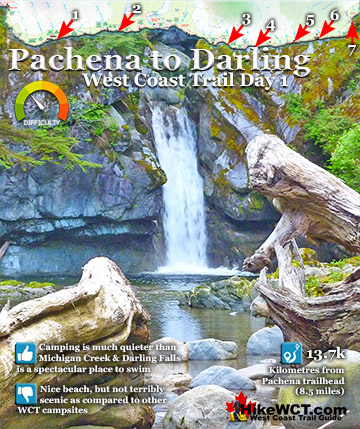
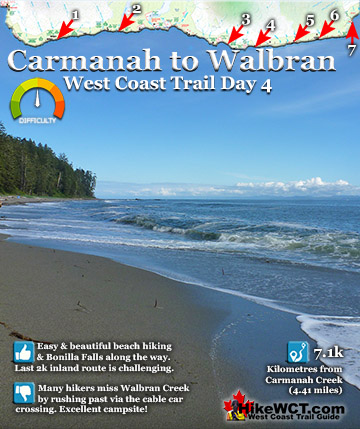
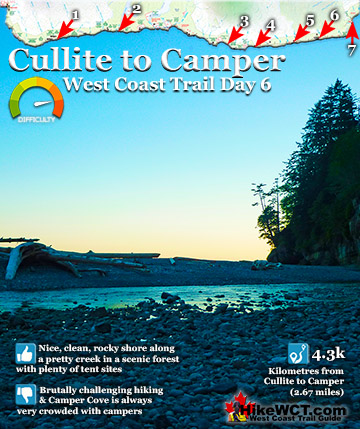

Explore BC Hiking Destinations!
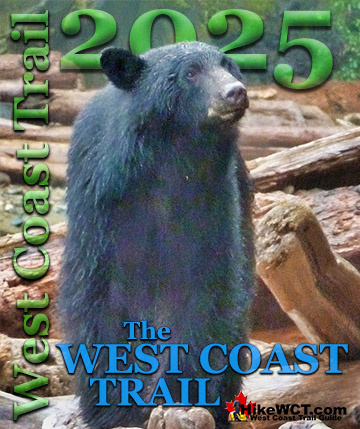
The West Coast Trail

Victoria Hiking Trails

Clayoquot Hiking Trails

Whistler Hiking Trails
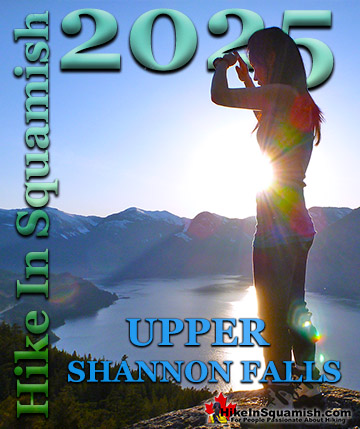
Squamish Hiking Trails

Vancouver Hiking Trails

